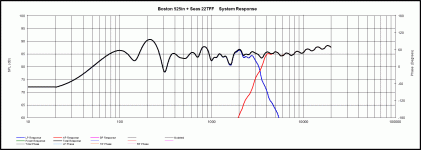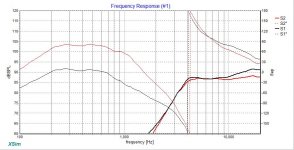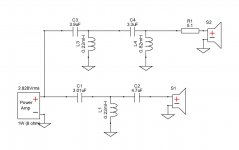I recently purchased a pair of the Hosa Cue-5 speaker without its digital electronics on ebay. I plan to use it with my computer, replacing a pair of Minimus 7.
Hosa Technology Introduces Cue 5 Digital Monitoring System With Binary Drive
The cabinet seems to be very solidly constructed. It has a 5.25" cast frame woofer and a 1" dome tweeter with double magnets. The drivers seems to be very high quality, but the crossover is only a single 3.3 uF capacitor.
Anyone knows what those drivers are. The woofer says "Boston". The tweeter has no marking. I think that it is worth the investment of a better crossover.
Hosa Technology Introduces Cue 5 Digital Monitoring System With Binary Drive
The cabinet seems to be very solidly constructed. It has a 5.25" cast frame woofer and a 1" dome tweeter with double magnets. The drivers seems to be very high quality, but the crossover is only a single 3.3 uF capacitor.
Anyone knows what those drivers are. The woofer says "Boston". The tweeter has no marking. I think that it is worth the investment of a better crossover.
No.
Some of the best speakers have a simple, low count component #, crossover. The likes of classic Dynacos, Mordaunt-Shorts have only one cap. Thats only possible with the best drivers & design.
Some of the best speakers have a simple, low count component #, crossover. The likes of classic Dynacos, Mordaunt-Shorts have only one cap. Thats only possible with the best drivers & design.
RJB
Without specific information on the drives of the Cue 5, my backup plan is to start with the crossover from Roman Bednarek 's Microbe SE and modify.
Microbe SE
With my ears and help from ARTA measurement, I am confident that I can get reasonable results.
Without specific information on the drives of the Cue 5, my backup plan is to start with the crossover from Roman Bednarek 's Microbe SE and modify.
Microbe SE
With my ears and help from ARTA measurement, I am confident that I can get reasonable results.
Hi,
The Microbe x/o is not a good starting point,
the bassmid notch filter is probably not needed.
rgds, sreten.
The Microbe x/o is not a good starting point,
the bassmid notch filter is probably not needed.
rgds, sreten.
Hi,
The Microbe x/o is not a good starting point,
the bassmid notch filter is probably not needed.
rgds, sreten.
I will not try to explain what the term "starting point" mean to you.
The notch filter will most likely have to be different. I won't know if the cue-5 woofer needs one or not until I test it.
This turned out to be one of the best inexpensive, one weekend speaker project I do recently.
I ended up with the crossover below by trial and error using the measured SPL curves.
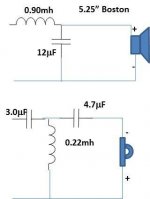
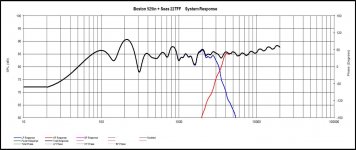
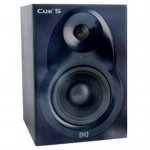
The crossover is a 2nd order LP and 3rd order HP. When combined with the driver, it is an effective 4th order symmetrical one.
The small Hosa cabinet is 10"Hx8-3/4"Dx7"W with a rear facing slot bass reflex. I usually prefer closed box design. But this little box has useful output down to almost 50Hz. The overall response is very smooth. For a total investment of less than $100, I am very satisfied.
When the Hosa Cue-5 monitor was introduced in 2007, it was $899 a pair and advertised as a close space studio monitor. It was not very well received partially because the speaker is ahead of its time and partially because Hosa is known for low end gears. You can now buy it with the cabinet, or drivers only or woofer only or tweeter only from Dalaudio.
I ended up with the crossover below by trial and error using the measured SPL curves.



The crossover is a 2nd order LP and 3rd order HP. When combined with the driver, it is an effective 4th order symmetrical one.
The small Hosa cabinet is 10"Hx8-3/4"Dx7"W with a rear facing slot bass reflex. I usually prefer closed box design. But this little box has useful output down to almost 50Hz. The overall response is very smooth. For a total investment of less than $100, I am very satisfied.
When the Hosa Cue-5 monitor was introduced in 2007, it was $899 a pair and advertised as a close space studio monitor. It was not very well received partially because the speaker is ahead of its time and partially because Hosa is known for low end gears. You can now buy it with the cabinet, or drivers only or woofer only or tweeter only from Dalaudio.
Attachments
Last edited:
Hi Keilau. I just bought a pair of these Cue-5 speakers and am hoping you're still available to answer a few questions:
1. What did you think of them when they just had the 3.3 uf capacitor?
2. How did your mod improve the sound?
3. Now that you've had them a few years, would you say it is worth my time to duplicate your mod? If so, any additional specifications you can off on ordering the parts would be helpful.
Thank you.
1. What did you think of them when they just had the 3.3 uf capacitor?
2. How did your mod improve the sound?
3. Now that you've had them a few years, would you say it is worth my time to duplicate your mod? If so, any additional specifications you can off on ordering the parts would be helpful.
Thank you.
For such a flat tweeter the filter used leaves an exaggerated top octave response. The slope at the crossover point is nice, but the top octave is like 5 dB above the rest. Ouch! It's an unnecessary sacrifice. Adjust the tweeter so the top 2 octaves match the woofer's middle level via an L-Pad or resistor first. Then add the hp filter components.
I'd spend more time with the design. 4th order acoustic is cool, but rarely does anything much better than 2nd order. It's better to have a pair of second order filters if your phase and amplitude match than 4th that sacrifices.
Here's an example which does away with the FR vs. crossover point compromise. It could still stand to be tuned more.

Let's compare the FRD and phase plots:

As you can see, the response peak around 16kHz has been brought down by 3 dB or so while maintaining a close slope and phase match.
Like I said though, more can be done to flatten the response even more. The tweeter itself is pretty flat, take advantage of that instead of compromising it. 🙂
Best,
Erik
I'd spend more time with the design. 4th order acoustic is cool, but rarely does anything much better than 2nd order. It's better to have a pair of second order filters if your phase and amplitude match than 4th that sacrifices.
Here's an example which does away with the FR vs. crossover point compromise. It could still stand to be tuned more.
Let's compare the FRD and phase plots:
As you can see, the response peak around 16kHz has been brought down by 3 dB or so while maintaining a close slope and phase match.
Like I said though, more can be done to flatten the response even more. The tweeter itself is pretty flat, take advantage of that instead of compromising it. 🙂
Best,
Erik
Attachments
Last edited:
I went from the seas datasheets to the levels don't match exactly, but you get the idea. Also, that ripple in the tweeter.. gnarly. I'd suggest adding a felt ring to the wave guide or something.
But for $100 and a weekend project I guess it's alright. 🙂
Best,
Erik
But for $100 and a weekend project I guess it's alright. 🙂
Best,
Erik
thanks for your input, erik. Unfortunately, I'm a musician with limited electrical knowledge and most of this is over my head.
What might I expect from the single 3.3 uf capacitor it comes with?
Can you recommend a pre-built crossover I could pick up online?
What might I expect from the single 3.3 uf capacitor it comes with?
Can you recommend a pre-built crossover I could pick up online?
Unnfortunately without the full set of original measurements its going to be hard to tell, but based on the additional bass filters i suspect the speaker will significantly lack any bass. the original mods fixthis at the expense of lower output.
The seas tweeter is pretty sweet so its a shame its not better matched to the woofer.
If you had more electronics i would suggest you take the mods low pass and my new high pass.
Do you have a speaker budget?
Erik
The seas tweeter is pretty sweet so its a shame its not better matched to the woofer.
If you had more electronics i would suggest you take the mods low pass and my new high pass.
Do you have a speaker budget?
Erik
thanks very much for your interest, Erik.
here's my situation. I need an accurate mixing setup. My budget was really spent on a pair of Yamaha MSR100 powered speakers, which I will keep for live use, but are a little to big for my desktop. I'd like to use my Yamaha TSX10 receiver which outputs 16 watts per channel to 4 ohm outputs.
My budget is under $200 for passive speakers. There aren't many available and ironically there is a nice selection of bi-amped monitors at that price, including M-Audio's BX5's which I used to have but they ran too hot. Also, I prefer less cable clutter and the flexibility of choosing my audio amp.
I aspired to go to college for electrical engineering as a kid, but I never took one class or built a single circuit, so your diagrams are a little over my head. These Cue-5 speakers seem like a good option if I could accomplish a simple upgrade. I'd consider salvaging crossovers from a decent, but old set of speakers at Goodwill or buying a crossover online if I knew what specs to look for.
here's my situation. I need an accurate mixing setup. My budget was really spent on a pair of Yamaha MSR100 powered speakers, which I will keep for live use, but are a little to big for my desktop. I'd like to use my Yamaha TSX10 receiver which outputs 16 watts per channel to 4 ohm outputs.
My budget is under $200 for passive speakers. There aren't many available and ironically there is a nice selection of bi-amped monitors at that price, including M-Audio's BX5's which I used to have but they ran too hot. Also, I prefer less cable clutter and the flexibility of choosing my audio amp.
I aspired to go to college for electrical engineering as a kid, but I never took one class or built a single circuit, so your diagrams are a little over my head. These Cue-5 speakers seem like a good option if I could accomplish a simple upgrade. I'd consider salvaging crossovers from a decent, but old set of speakers at Goodwill or buying a crossover online if I knew what specs to look for.
in reply to my inquiry, the speaker seller said he tried a complex crossover, but using an analyzer, the output flat response was only marginally improved. He said some customers have been happy using these crossovers: Ajustable Treble Bass Frequency Divider 2 Way Speaker Audio Crossover Filters | eBay
it would be cheap and quick. What do you think?
it would be cheap and quick. What do you think?
I ordered the crossovers.
Erik, I didn't see any information on it being a SEAS tweeter. Do you know any details about this speakers?
The seas tweeter is pretty sweet so its a shame its not better matched to the woofer.
Erik
Erik, I didn't see any information on it being a SEAS tweeter. Do you know any details about this speakers?
Sonny, if you could make your own cabinets I'd suggest these:
A Speaker Maker's Journey: Introduction to The W. Marshal Leach Jr. Memorial Speakers
Pay particular attention to this page, where I discuss how to make a pair for around $210 a pair:
A Speaker Maker's Journey: LM-1 Parts, Costs and Alternatives
A Speaker Maker's Journey: Introduction to The W. Marshal Leach Jr. Memorial Speakers
Pay particular attention to this page, where I discuss how to make a pair for around $210 a pair:
A Speaker Maker's Journey: LM-1 Parts, Costs and Alternatives
No.
Some of the best speakers have a simple, low count component #, crossover. The likes of classic Dynacos, Mordaunt-Shorts have only one cap.
Not necessarily true. Possibly, maybe, true for a simple unambitious 2-way.
Definitely not true for TOTL state-of-the art systems.
M.
- Status
- Not open for further replies.
- Home
- Loudspeakers
- Multi-Way
- Hosa Technology Cue-5 Monitor Speaker driver information
